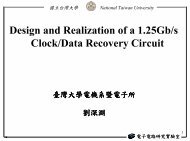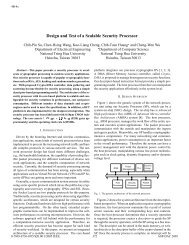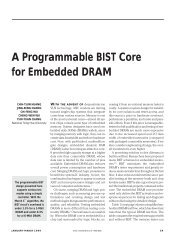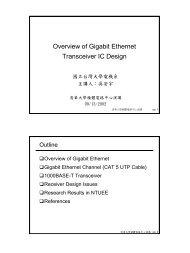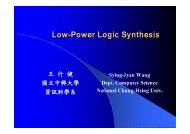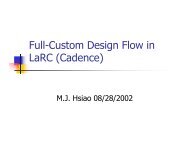A robust feedforward compensation scheme for multistage ...
A robust feedforward compensation scheme for multistage ...
A robust feedforward compensation scheme for multistage ...
You also want an ePaper? Increase the reach of your titles
YUMPU automatically turns print PDFs into web optimized ePapers that Google loves.
THANDRI AND SILVA-MARTÍNEZ: ROBUST FEEDFORWARD COMPENSATION SCHEME FOR MULTISTAGE OTAS WITH NO MILLER CAPACITORS 241<br />
(a)<br />
Fig. 8.<br />
OTA pulse response in noninverting unity-gain (buffer) configuration.<br />
(b)<br />
Fig. 7. Open-loop ac response of the OTA. (a) Magnitude response. (b) Phase<br />
response.<br />
level (1.25 V) is generated. In the technology used, the typical<br />
threshold voltage of an nMOS transistor is 700 mV and<br />
<strong>for</strong> a pMOS transistor is 900 mV. The first stage of the amplifier<br />
(telescopic cascode) was designed <strong>for</strong> maximum gain<br />
per<strong>for</strong>mance and relatively small time constant (<br />
pF/700 AV ns). The swing of the first stage need<br />
not be high (it is typically in the order of a few millivolts) as it is<br />
amplified further by the gain of the second stage. The dc bias of<br />
transistor M1 is at ground and the dc bias <strong>for</strong> M4 and M5 are set<br />
by a bias circuit. The transconductance of the second and <strong>feed<strong>for</strong>ward</strong><br />
stage is increased as much as possible to push the poles<br />
to high frequencies: mA/V and mA/V.<br />
Since the values of the first pole and the LHP zero depend on<br />
parasitic capacitances and the feedback factor, exact cancellation<br />
may not be possible; however, the effect of the pole–zero<br />
mismatch is small because the partial cancellation occurs at high<br />
frequencies.<br />
This structure is well suited <strong>for</strong> fully differential implementation,<br />
where the reduced number of parasitic poles (due to the<br />
absence of differential to single-ended conversions) makes the<br />
structure faster. In this case, additional common-mode feedback<br />
circuits have to be added <strong>for</strong> both the first and second stage to<br />
control the common-mode voltages.<br />
V. EXPERIMENTAL AND SIMULATION RESULTS<br />
The simulated open-loop ac magnitude and phase response<br />
of the single-ended OTA is shown in Fig. 7(a) and (b), respec-<br />
Fig. 9. Pulse response post-layout simulation—parametric sweep of feedback<br />
and load capacitors.<br />
Fig. 10.<br />
Microphotograph of the OTA.<br />
tively. The load capacitor used in the simulations was 8 pF<br />
and the design was optimized <strong>for</strong> this loading. The OTA dc<br />
gain, unity-gain frequency, and phase margin are around 94 dB,<br />
300 MHz, and 74 , respectively. The OTA pulse response <strong>for</strong><br />
a noninverting unity-gain configuration (buffer configuration)<br />
loaded by a capacitor of 8 pF is shown in Fig. 8. An input step<br />
of 400 mV and 100-ps rise time was used <strong>for</strong> the simulations,<br />
and 1% settling time is less than 7 ns. Parametric sweep simulations<br />
<strong>for</strong> the capacitive amplifier with<br />
(see




